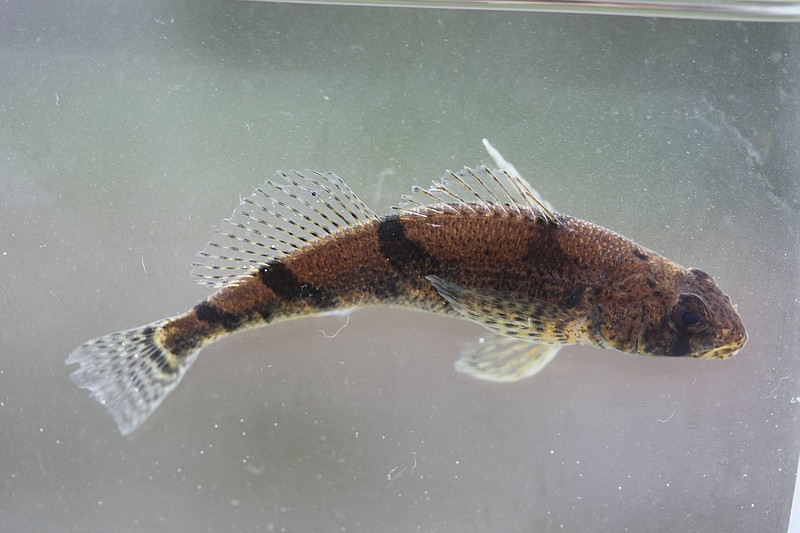The snail darter - a little three-inch fish that nearly swallowed TVA's Tellico Dam and became the poster child for the Endangered Species Act - has officially been saved from extinction and removed from the nation's list of imperiled wildlife.
It's a rare victory, but not one with a completely happy ending.
The fish was saved, but the long-time landowners eventually were displaced by the TVA dam - some of them from 100-acre farms that the man-made Tellico Lake covered only about three acres of.
And even while the snail darter was saved - largely by court-forced efforts from TVA to relocate the fish into other reaches of nearby East Tennessee rivers and streams, along with a special river oxygenation system - the darter's delisting comes as United Nations scientists warn that around 1 million other types of animals and plants worldwide are threatened with extinction.
Most of the animals and plants now threatened won't have the public attention of the darter. Nor will they have the time to be saved. Many, in fact, are expected to become extinct within decades as their habitats are destroyed and temperatures rise because of human-caused climate change.
But the darter's real bright place in history - all of which played out right here in our backyard - is the role it played in cementing the Endangered Species Act of 1973.
With the darter's discovery that year in a soon-to-be flooded stretch of the Little Tennessee, construction stopped dead still on the then-$100 million dam that was 75% complete. Then began a major legal battle. The case, TVA v. Hill (as in Chattanooga attorney Hiram "Hank" Hill) made its way to the Supreme Court. The little fish became for some an icon of species preservation, and for others a hateful symbol of the environmental movement's alleged "radical" excesses.
The Supreme Court's 1978 ruling became the first interpretation of the new Endangered Species law. In short, the court made it clear the federal government had to protect imperiled plants and animals "whatever the cost." And the decision showed the American public - from federal dam developers to real estate developers, oil drillers, mall builders and others whose work affects threatened plants and animals - the power of the Endangered Species Act.
Today, despite some unsuccessful assaults by the former Trump administration to gut it, the nearly 50-year-old law can also be credited with saving the bald eagle, the peregrine falcon, the Tennessee purple coneflower, the Tennessee River's lake sturgeon, the American alligator, the humpback whale, the St. Francis' satyr butterfly in North Carolina and 2019's hatch of Roti Island snake-necked turtles and Komodo dragons at the Chattanooga Zoo, among many other animals and plants.
Republicans have long whined about the law, pointing to only a fraction of the more than 1,600 species declared imperiled that have made it off the list. On the other hand more than 99.2% of the species protected by the act survive. Only 11 species have since been declared extinct, having already pretty much died out when they were listed.
Listening to lobbyists, loggers, ranchers and other business interests, the Trump administration shaved off long-standing protections and made rule changes requiring wildlife managers to take into account the economic cost to the industry or developer when deciding whether to protect a species. In effect, those rules, which changed the endangered species process in 30 ways, would have endangered the Endangered Species Act.
Think of it this way: Had the chemical and pesticide industry had its way, DDT would still be in widespread use on farms and orchards. Not only would the eagle likely be extinct, but many other birds whose eggshells were weakened by the chemical would be, too. Along the way, more of us might have succumbed to cancer and/or seen our children harmed by birth defects. Instead, DDT - eventually found to be a probable human carcinogen and reproductive toxin - was discontinued in the United States.
The Biden administration in June announced plans to reverse the Trump policies.
Science, given even just half a chance, can save us from ourselves - if we're careful to stir in morally right motives.
The snail darter, the bald eagle and the Endangered Species Act offer perfect examples.
The lawsuit, TVA v. Hill, shaped environmental law in the country for the better, but Hill, then a law student who became the sole named plaintiff, said during a 2008, 30-year retrospective of the case that they "won all the battles but lost the war." TVA displaced scores of landowners to build a non-power generating dam and reservoir and sell land that created a crop of "McMansions" along the lake formed from the once free-flowing Little Tennessee River. The dam was finished and the gates closed in 1979 after Congress exempted the Tellico from the environmental law.
From the perspective of environmental law, nearly 50 years of science and democracy show we can have a far-sighted, environmentally conscious law that can still allow for dam building, job growth and town development. But they don't make farmland anymore.
Science and democracy make a good habitat for us when we work at it. We did well by the snail darter. It's too bad we haven't looked out as well for ourselves, for the Tellico farmers and for our "only one" Earth.
